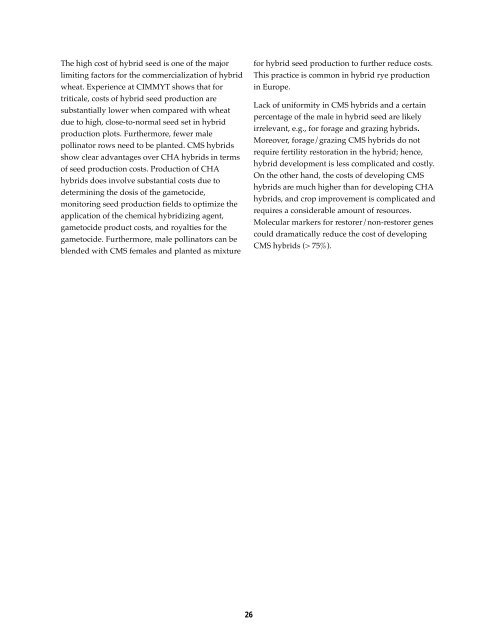Research Highlights of the CIMMYT Wheat Program 1999-2000
Research Highlights of the CIMMYT Wheat Program 1999-2000
Research Highlights of the CIMMYT Wheat Program 1999-2000
You also want an ePaper? Increase the reach of your titles
YUMPU automatically turns print PDFs into web optimized ePapers that Google loves.
The high cost <strong>of</strong> hybrid seed is one <strong>of</strong> <strong>the</strong> major<br />
limiting factors for <strong>the</strong> commercialization <strong>of</strong> hybrid<br />
wheat. Experience at <strong>CIMMYT</strong> shows that for<br />
triticale, costs <strong>of</strong> hybrid seed production are<br />
substantially lower when compared with wheat<br />
due to high, close-to-normal seed set in hybrid<br />
production plots. Fur<strong>the</strong>rmore, fewer male<br />
pollinator rows need to be planted. CMS hybrids<br />
show clear advantages over CHA hybrids in terms<br />
<strong>of</strong> seed production costs. Production <strong>of</strong> CHA<br />
hybrids does involve substantial costs due to<br />
determining <strong>the</strong> dosis <strong>of</strong> <strong>the</strong> gametocide,<br />
monitoring seed production fields to optimize <strong>the</strong><br />
application <strong>of</strong> <strong>the</strong> chemical hybridizing agent,<br />
gametocide product costs, and royalties for <strong>the</strong><br />
gametocide. Fur<strong>the</strong>rmore, male pollinators can be<br />
blended with CMS females and planted as mixture<br />
for hybrid seed production to fur<strong>the</strong>r reduce costs.<br />
This practice is common in hybrid rye production<br />
in Europe.<br />
Lack <strong>of</strong> uniformity in CMS hybrids and a certain<br />
percentage <strong>of</strong> <strong>the</strong> male in hybrid seed are likely<br />
irrelevant, e.g., for forage and grazing hybrids.<br />
Moreover, forage/grazing CMS hybrids do not<br />
require fertility restoration in <strong>the</strong> hybrid; hence,<br />
hybrid development is less complicated and costly.<br />
On <strong>the</strong> o<strong>the</strong>r hand, <strong>the</strong> costs <strong>of</strong> developing CMS<br />
hybrids are much higher than for developing CHA<br />
hybrids, and crop improvement is complicated and<br />
requires a considerable amount <strong>of</strong> resources.<br />
Molecular markers for restorer/non-restorer genes<br />
could dramatically reduce <strong>the</strong> cost <strong>of</strong> developing<br />
CMS hybrids (> 75%).<br />
26

















